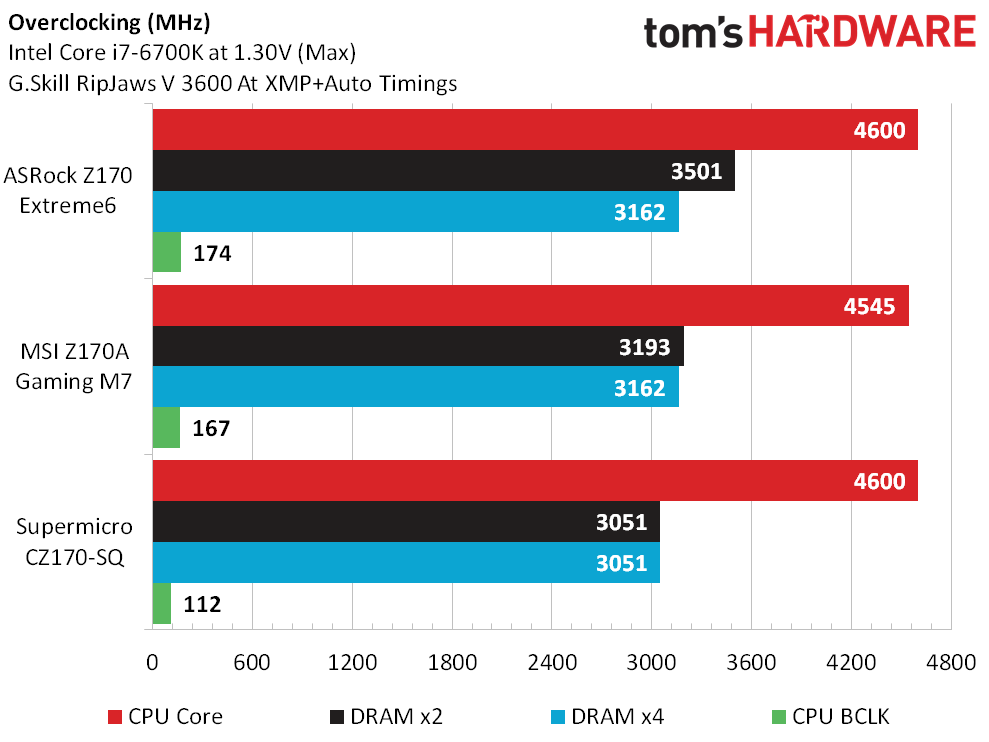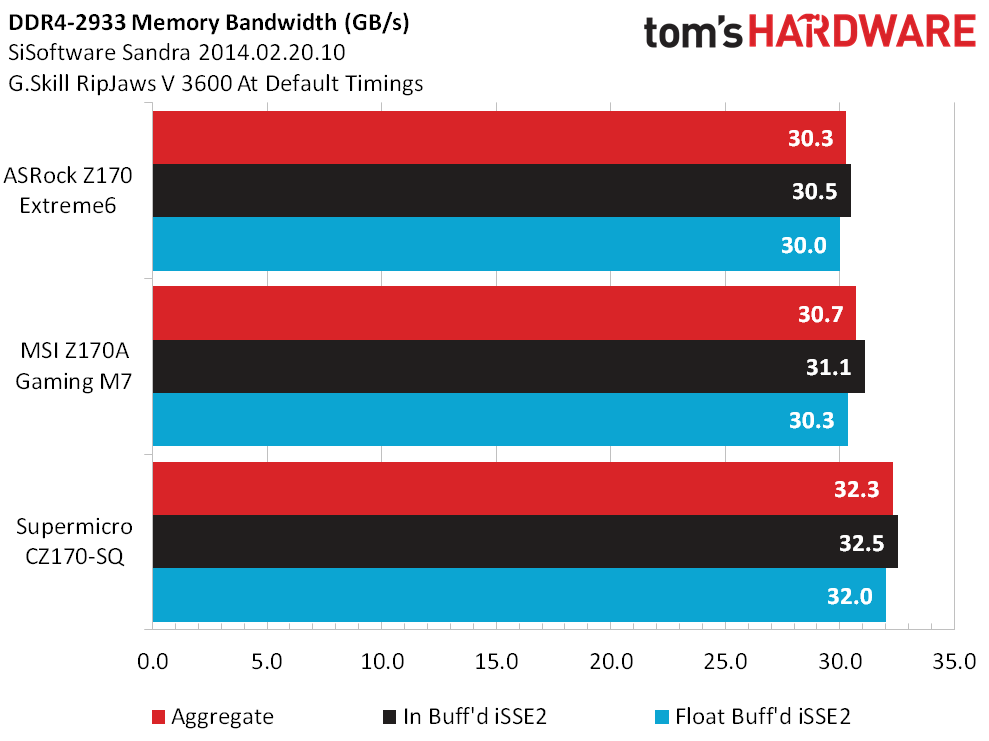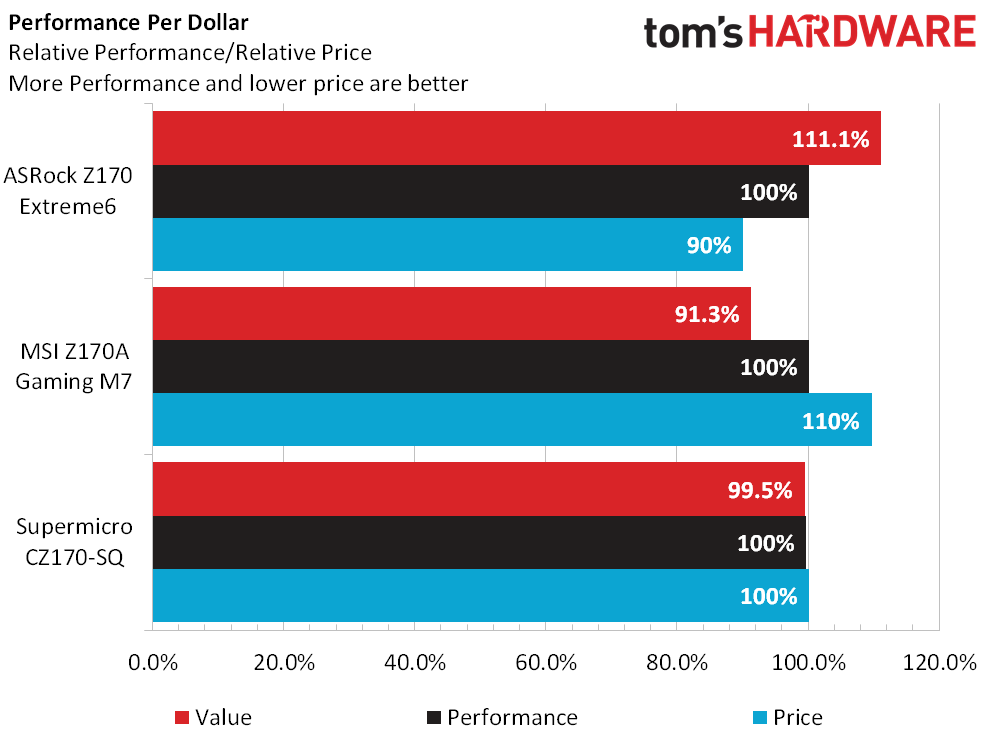Intel Z170 LGA-1151 Motherboard Roundup
ASRock, MSI and Supermicro offered up their Z170 Extreme6, Z170A Gaming M7 and C7Z170-SQ (respectively) for our initial Z170 motherboard roundup.
Why you can trust Tom's Hardware
Overclocking, Value And Final Analysis
Certain settings, such as multipliers beyond 83x on Skylake, can’t be set in hardware even when available in firmware. Other settings, such as 0.0 volts, won’t give a component any energy to operate. That’s why we take the range of overclock settings for each board with a grain of salt.
Overclocking Frequency & Voltage Settings
| Header Cell - Column 0 | ASRock Z170 Extreme6 | MSI Z170A Gaming M7 | Supermicro C7Z170-SQ |
|---|---|---|---|
| BIOS | L1.01L (07/21/2015) | P1.42 (07/23/2015) | 1.0 (07/24/2015) |
| Base Clock | 90-600MHz (62.5kHz) | 70-290MHz (60kHz) | 0-655MHz (10kHz) |
| CPU Multiplier | 8x-120x (1x) | 8x-83x (1x) | 0x-83x (1x) |
| DRAM Data Rates | 800-4133 (200/266.6 MT/s) | 800-4133 (200/266.6 MT/s) | 800-4800 (200/266.6 MT/s) |
| CPU Vcore | 0.90-1.52V (5mV) | 0.60-2.15V (5mV) | 0-2.0V (1mV) |
| System Agent | 0.95-1.35V (10mV) | 0.60-2.00V (10mV) | 1.04-1.73V (1mV) |
| CPU I/O | 0.85-1.50V (5mV) | 0.60-2.00V (10mV) | 975, 1163, 1315mV |
| PCH Voltage | 0.90-1.30V (5mV) | N/A | 1.00-1.32V (~58mV) |
| DRAM Voltage | 1.00-1.80V (5mV) | 0.60-2.20V (10mV) | 1.20-1.52V (~50mV) |
| CAS Latency | 4-31 Cycles | 4-31 Cycles | 0-31 Cycles |
| tRCD | 8-31 Cycles | 4-31 Cycles | 0-63 Cycles |
| tRP | 8-31 Cycles | 4-31 Cycles | 0-63 Cycles |
| tRAS | 28-63 Cycles | 28-63 Cycles | 0-64 Cycles |
Several sources are reporting “safe” voltage limits for Intel’s Skylake processors from 1.40 to 1.45V, yet I personally have a tough time believing the company's engineers have improved voltage handling to a great extent in a single generation. Lacking the data to show how many months of reliability I could expect under 100% load at those high voltage levels, I stuck with 1.30V
ASRock and Supermicro achieved the top CPU overclocks, though only ASRock was prepared to use our DDR4-3600 memory samples. MSI is somewhat aggressive at firmware development, so we expect the race to tighten as we move on to review more mature products.
Then again, some motherboards use loose tertiary timings to increase memory overclock capability, losing performance in the process. Supermicro appears to lead the DDR4-2933 race only because its board couldn’t adjust timings automatically to increase stability. ASRock seems to lose this race while also leading the DRAM overclocking competition. And MSI’s middle position doesn’t look so bad when its two competitors swap places. Until someone does something extraordinary with their memory configurations, the rightful overclocking crown remains limited to CPU core clock where ASRock and Supermicro are tied.
A performance per dollar chart like the one above doesn’t compensate for the added cost of connectors, controllers and switches needed to turn a basic platform into a high-end motherboard. So MSI’s loaded-up $229 board looks like a modest value compared to ASRock’s more basic part. The question of whether the Z170A Gaming M7’s upgraded Killer e2400 network controller is worth more than the Z170 Extreme6’s extra SATA controller is probably best left to you and your needs. But MSI is very keen on its added Nahimic audio software, extra M.2 interface and one-year premium service upgrade for XSplit Gamecaster. The company's motherboard software is also far more advanced than ASRock’s, and the ASIC required for BIOS Flashback must be worth something. If you’re overclocking with LN2, the Slow Mode switch is invaluable as well. But are all of those differentiators worth $40?
Yes, they probably are. Of course, giving MSI a $40 credit without taking away some points for things that ASRock does right, such as its dual socket-mounted firmware and selection jumper, probably wouldn’t be right. And ASRock did win the overclocking competition.
So who gets the prize? ASRock might, except that I can't really give an award based on overclocking determined through beta firmware. MSI comes up next, except that it probably would have needed a little bit of that beta firmware treatment to overcome its slight overclocking deficit. So at this point, I’m going to reserve any awards for future products and use these $190, $210 and $230 boards as my baseline for comparing the improvements of our next round-up.
Get Tom's Hardware's best news and in-depth reviews, straight to your inbox.
ASRock Z170 Extreme6
MSI Z170A Gaming M7
SuperMicro C7Z170-SQ
Update 8-07-2015
ASRock informed us ahead of time that its Z170 Extreme6 would be $180, but the cheapest launch-day price we found was $190 at Newegg. That vender has since lowered the price, as promised, to $180. This cost savings makes the Z170 Extreme6 an even better bargain for value seekers, particularly those who want to heavily overclock their memory.
MORE: Best MotherboardsMORE:
How To Choose A Motherboard: A Guide For BeginnersMORE: All Motherboard Articles
MORE: Latest Motherboard NewsMORE: Motherboards in the Forums
Thomas Soderstrom is a Senior Staff Editor at Tom's Hardware, covering Cases, Cooling, Memory and Motherboards. Follow him on Twitter.
Follow Tom's Hardware on Twitter, Facebook and Google+.
Current page: Overclocking, Value And Final Analysis
Prev Page Benchmarks, Power, Heat And Efficiency-
Crashman Reply
Read it again :-) Notice anything about capitalization?16403363 said:You i7 is two cores? XD
(Last paragraph of first page)
-
danlw Glad to see the Extreme 6 I bought from Newegg the other day fared well. Now, about i7 6700K US availability... amazon.DE and amazon.fr both showed the 6700k for sale yesterday... why is the 6700K (and 6600k) MIA in the US?Reply -
TechyInAZ Those motherboards are cool, looks great!Reply
No ASUS boards!!!
No GIGABYTE either!?? :D -
AdviserKulikov Tom's staff,Reply
Please get rid of the arrows covering the charts.
Thanks,
-The Readers -
Calculatron ASRock scores another victory!Reply
It's a shame that Asus and Gigabyte didn't send in a competing board.
(Dare I say anything about Biostar again?)



